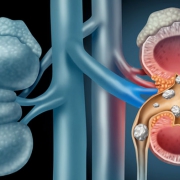Learn All About Bladder Cancer!
By Dr. A. Keith Levinson
Bladder cancer is the fifth most common cancer in the United States. Nearly 82,000 people will be diagnosed in the United States with bladder cancer in 2018, and there were an estimated 16,000 bladder cancer deaths in the U.S. in 2015.
Bladder cancer is more common in males than females at a ratio of approximately 3:1. Learn your potential risk and more about this cancer below.
There Are Multiple Risk Factors Associated with Bladder Cancer
- Smoking is the most significant and common risk factor. It is estimated to contribute to the development of 50% of bladder cancers. Former smokers still remain at a higher risk than those who never smoked.
- Workplace exposure to chemicals used to make plastics, paint, textiles, and rubber.
- Cancer patients treated with the chemotherapy drug cyclophosphamide or pelvic radiation therapy may be at an increased risk.
- Patients with chronic bladder inflammation related to prolonged urinary catheters or infection are at increased risk.
- Patients with a hereditary condition called Lynch syndrome may be at an increased risk as well.
Symptoms of Bladder Cancer
There is no general screening recommendation for detecting bladder cancer. Most patients present with these symptoms of the disease.
- The most common presenting symptom of bladder cancer is blood in the urine, otherwise known as hematuria. It is usually painless. This may be in the form of obvious visible red blood called gross hematuria or microscopic hematuria, where blood is noted under the microscope by your doctor. Symptoms may also include frequent and urgent urination in the absence of documented infection.
- Hematuria should never be ignored. Not everyone with blood in the urine has cancer but it is important that even one episode be brought to the attention of your doctor and evaluated.
Diagnostic Tests for Bladder Cancer
Patients presenting with gross hematuria will typically undergo a full body imaging test called a CT or CAT scan. Usually, a cystoscopy will be performed as well. This is a short test done under local anesthesia where the urologist will use a flexible telescope to look inside the bladder. If a mass in the bladder is seen, the next step is to perform a biopsy and hopefully resect the lesion under anesthesia. A visual resectoscope is used to do this. This procedure is called a transurethral resection of a bladder tumor or TURBT. This is usually done as an outpatient procedure with a short recovery time.
Types of Bladder Cancer
The most common bladder cancer involves the lining of the bladder and is called transitional cell carcinoma. 75% of bladder cancers are noninvasive or superficial and 25% have already invaded the muscular wall of the bladder at diagnosis. Invasive tumors have the potential to spread to other parts of the body through the bloodstream and lymph nodes.
Once a cancer diagnosis is made, treatment recommendations depend on certain prognostic factors including:
- Stage: depth of local tumor invasion and extent of spreading potentially to the pelvic lymph nodes and other organs.
- Grade: the aggressiveness of tumor cells under the microscope is graded on a scale of 1-3. Grade three tumors are the most aggressive or fast growing.
Tissue Type or Pathology
Most bladder cancers are transitional cell cancers. Less common types include Adenocarcinoma, Squamous cell, Sarcomas, and small cell carcinomas.
Treatment
Once stage, grade, and pathology are accounted for, bladder cancers can be classified as low, medium, or high risk:
- Low risk: These tumors are at low risk for progression and after resection can often be followed with interval cystoscopy. In some cases, the urologist may instill a one-time chemotherapy treatment (Mitomycin) into the bladder immediately after TURBT which decreases the risk of recurrence.
- Medium-risk patients may need further treatment with medications instilled directly into the bladder for 6 weeks or longer, followed by close follow up. An immunotherapy drug BCG is used most commonly.
- High-risk patients may need a prolonged course of bladder instillations with BCG for 1-2 years to decrease the risk of the tumor progressing to a more invasive disease. A minority of more advanced cases may require bladder removal along (Radical cystectomy) with possible chemotherapy.
In summary, bladder cancer is a common disease. There is hope and effective treatments for those with bladder cancer. It is important to avoid the above risk factors described, especially smoking, and to never ignore any signs of blood in the urine. Early detection and treatment are critical, so contact Georgia Urology if you suspect something is wrong.








